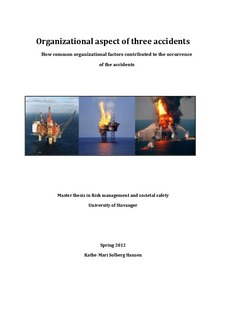| dc.description.abstract | In this thesis, two serious accidents and one major incident in the offshore drilling industry have been studied and compared. The main objective of this study was to seek out common organizational factors that contributed to these accidents. The findings clearly demonstrated that commonalities exist. Essentially, five factors represent recurring elements in these accidents: management, communication, competence, procedures, and compliance. How the regulatory regimes were organized also contributed to the accidents. These commonalities are important to examine so as to learn from mistakes that have already been made.
The importance of learning after an accident is not related to learning everything there is to know about the accident, but to organizations’ willingness to accept that they actually have something to learn and that a need exists to act more safely in the future (Turner & Pidgeon, 1997).
A shift in how we think about safety in the offshore industry is needed―where safety is not just something kept in mind, but rather the top priority. This shift should be facilitated by both the authorities and the industry as a whole. One cannot separate safety from other issues in the organization; however, safety is essential and applies to management, communication, compliance, procedures, competence, and regulatory regimes.
In this thesis, an analytical framework has been used to structure and compare the different accidents/incident. The main finding reflects the fact that to achieve an output that ensures both production and safety, there is a need to increase awareness of the process an organization goes through within its lifetime. This means that every organization goes through a drifting process where the kind of logic of action taken depends on the context of the organization, the tightness of the couplings, and the complexity of the situation. To what degree do the different subunits, which evolve in every organization, have their own logic of action (i.e., their own way of doing things)? The drifting process both affects and is affected by the management structure, the way in which communication systems function, the kinds of competence possessed, and whether it is possible to comply with organizational procedures and whether these procedures are in accordance with regulatory requirements. Finally, how the regulatory regimes in the different regions are organized varies, and no system is perfect. What is essential is the relationship between the regulator and the regulated organization. All parties are served by a good relationship because such a relationship contributes to achieving the common goal of being a financially sustainable organization and maintaining a high level of safety. | no_NO |
